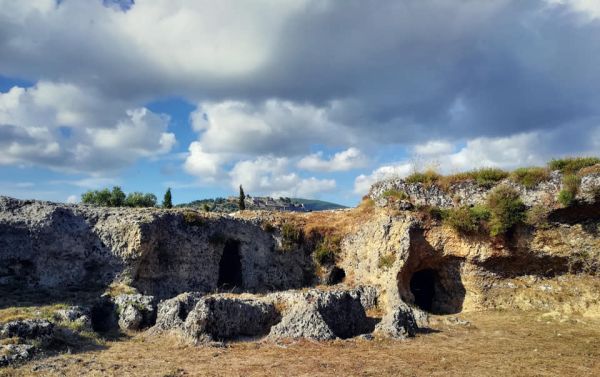The glorious Mycenaean past of Kefalonia is testified by 3 cemeteries that can still be visited today. While the cemetery of Lakithra is small, that of Mazarakata occupies a larger area. Located on the road between Argostoli and Pessada (you can reach it by following this link on Google Maps: https://goo.gl/maps/9FqN3r8wgrhS31p4A), it was brought to light when De Bosset, the English governor of the island between 1810 and 1814, ordered to find in this area the material necessary for the construction of a new road. De Bosset, who was of Swiss origin, led the excavations in their initial phase and had part of the finds transferred to a Swiss museum. The operations resumed about a century later and continued in 1951 by archaeologists of the island. In Mazarakata, 17 chamber tombs were discovered containing many vases and various artefacts. The tombs are carved into the rock and consist of a corridor, an entrance and a chamber. The dimensions of the chambers are different: the smaller ones (1.40 m x 1.90 m) house few burials, the larger ones (5.50 m × 4.80 m) a greater number of mounds. The Mazarakata site is the largest Mycenaean cemetery on the island and one of the most important archaeological sites in the Ionian Islands. The only vaulted tomb (tholos) on the island is found at Tzannata near Poros. It is the largest vaulted tomb so far found in the Ionian Islands and north-western Greece. The chamber has a diameter of 6.80m and the walls rise to a height of 3.95m. The dome of the tomb probably collapsed during the Venetian period and the tomb remained buried under the hill until its recent discovery in 1991. Although looted in antiquity, upon its discovery the tomb still contained precious artefacts such as clay pots, gold jewels, seals, a tiny gold axe, two gold rosettes, a gold plaque with reliefs. The size of the tomb and its location suggest the existence of a large Mycenaean centre in the area. A very important hypothesis for King Odysseus' search for the capital of the legendary kingdom of Ithaca, described so vividly in Homer's epics.
THE MYCENAEAN TOMBS OF KEFALONIA
The Mycenaean civilization flourished in Greece during the Late Bronze Age (1600-1100 BC). Sailors, shepherds and skilled warriors, in their travels the Mycenaeans brought with them their language and their customs, such as for example that of burying the deceased in large mounds containing well tombs. Tholos tombs were large circular rooms with a high vaulted roof and a straight entrance passageway lined with stone and were usually decorated with gold, silver and bronze. The deceased was often buried with daggers, gilded masks, diadems, armour and bejewelled weapons. These burial chambers are also mentioned in Homer's Iliad and Odyssey!

